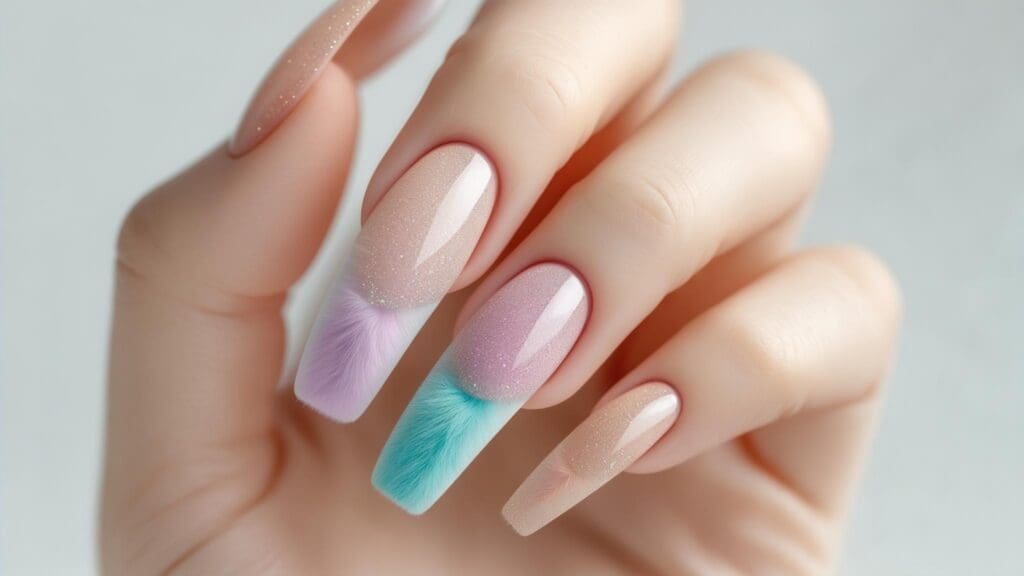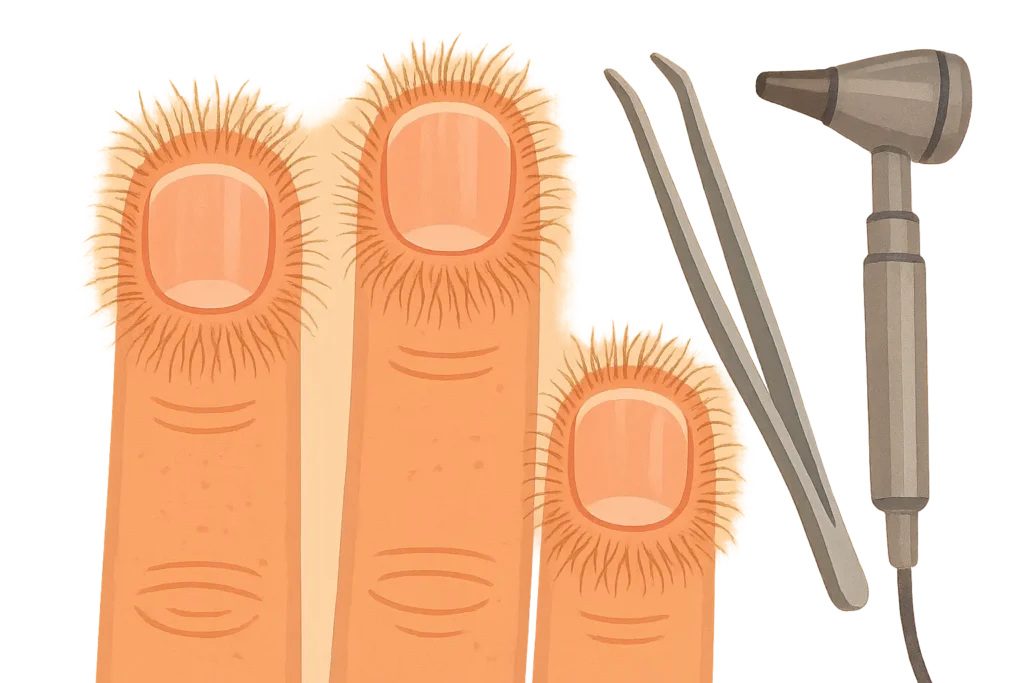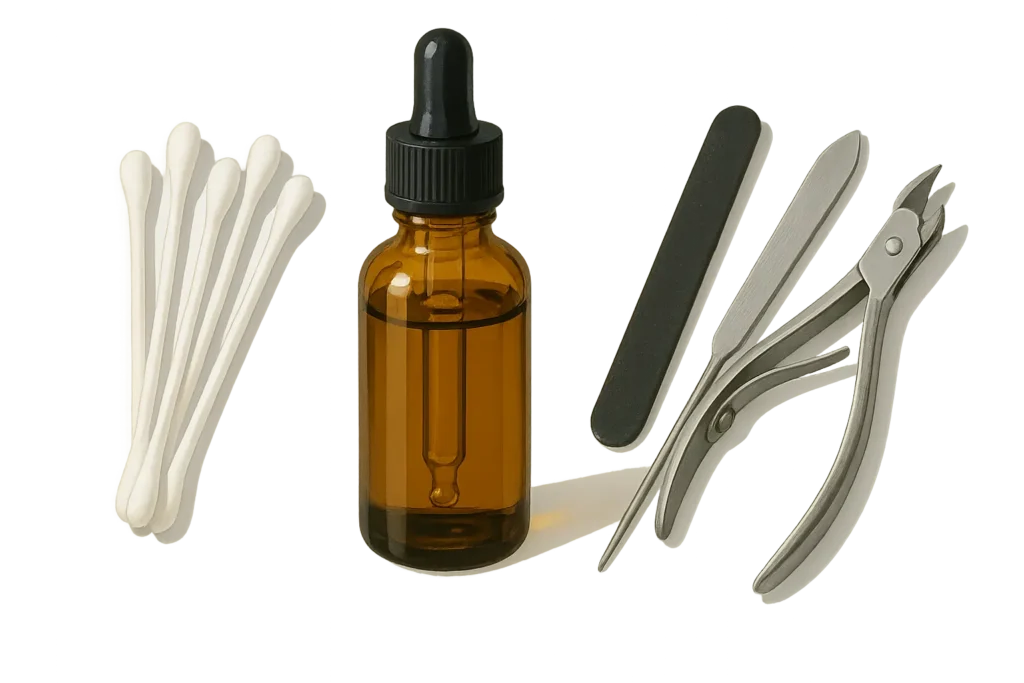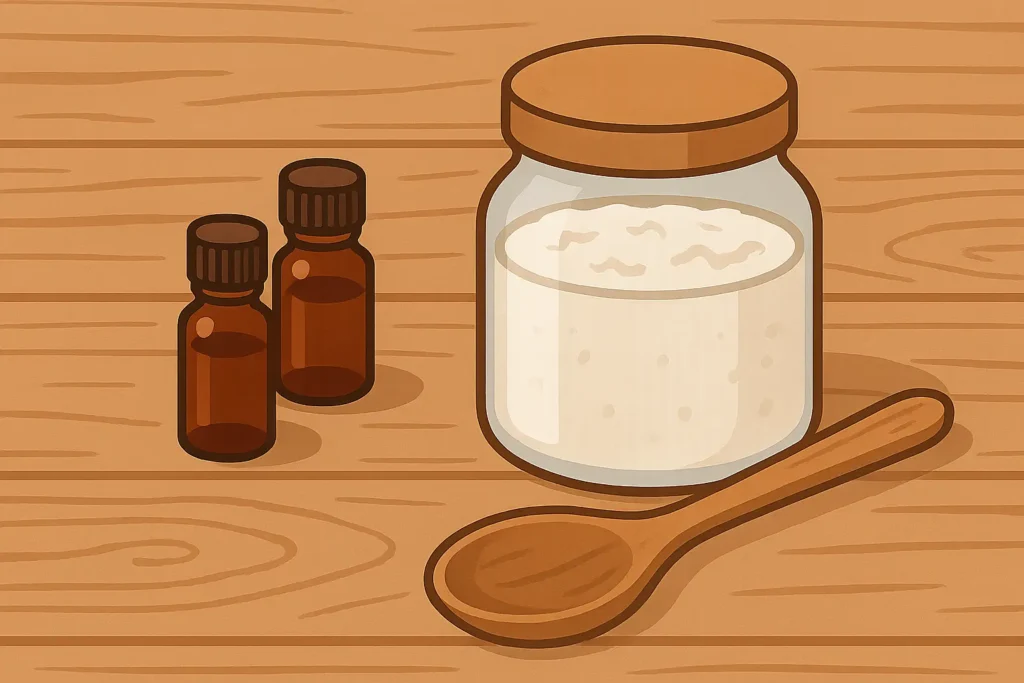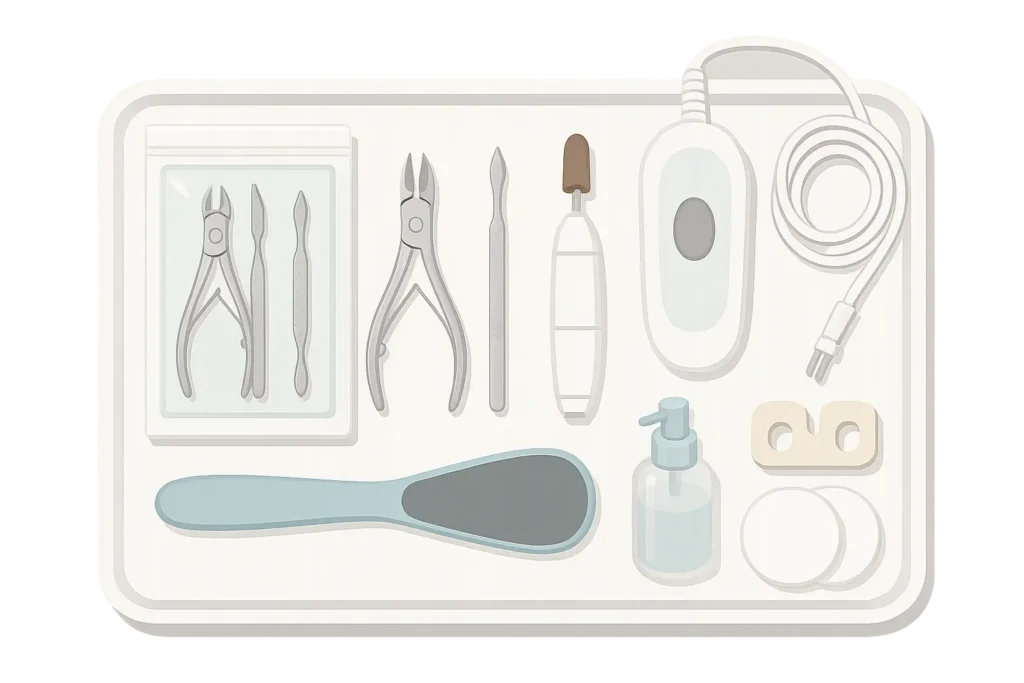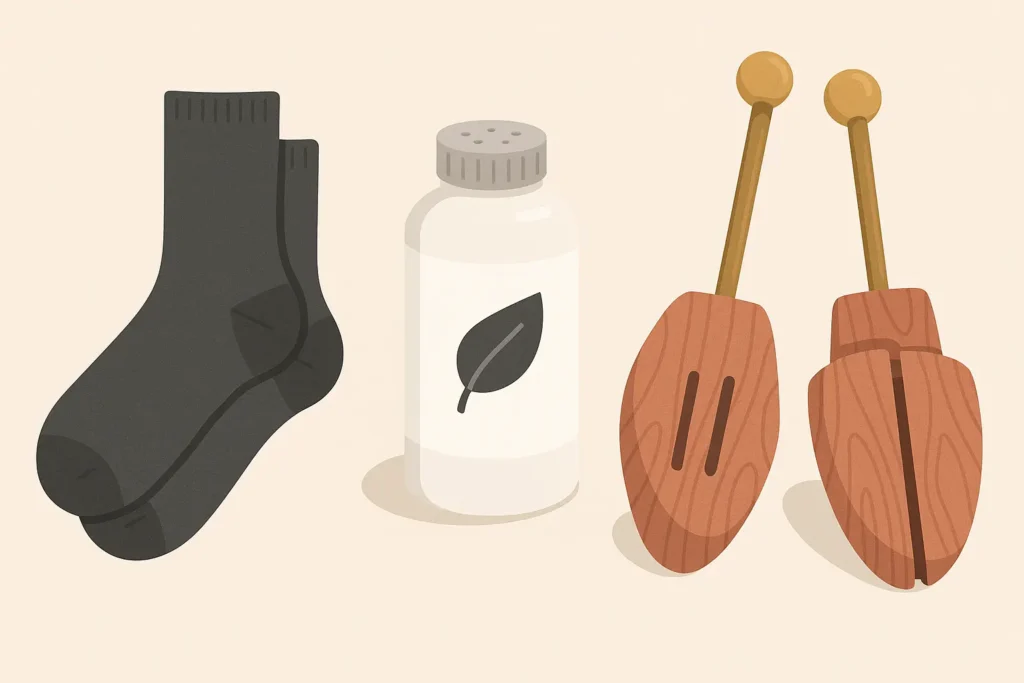The furry nails trend debuted at the Libertine Fall/Winter 2016 show, where models walked the runway with faux-fur nails, according to Momtastic Mommy Blog. Okay, so furry nails. I know what you’re thinking – “What the heck are furry nails, and why do I need to know about this?” Trust me, I had the same reaction. But if you’ve ever looked down at your nails and thought “Something’s not right here,” you’re definitely not alone.
Turns out, there’s a whole medical side to this that affects real people dealing with actual hairy nail conditions – and it’s way more common than you’d think. We’re talking about embarrassing situations and genuine health concerns that nobody really wants to Google at 2 AM.
Quick Resources:
-
Coordinate your nail treatments and wedding prep seamlessly with the AI Wedding Planner
-
Get personalized beauty color matches with our Color Analysis Quiz (Free)
-
Explore all our Wedding Tools for stress-free planning
Whether you’re dealing with fuzzy nail growth, unusual hair around your nail beds, or just curious about this phenomenon, you’re in the right place. I’ve compiled everything you need to know about furry nails, from medical treatments to home remedies that actually work.
For brides-to-be dealing with nail concerns before their big day, understanding proper nail care becomes even more crucial. Our comprehensive wedding planning guide includes beauty preparation tips to ensure every detail looks perfect for your special day.
Plan your full wedding beauty and nail prep timeline using the AI Wedding Planner
TL;DR
- Furry nail conditions can stem from fungal infections, hormonal imbalances, or genetic factors requiring different treatment approaches
- Medical treatments like antifungal medications and laser therapy offer 60-90% success rates for severe cases
- Over-the-counter solutions including tea tree oil and medicated lacquers provide accessible first-line treatments
- Natural remedies such as apple cider vinegar soaks and coconut oil blends offer gentle, cost-effective options
- Professional services from podiatrists and dermatologists ensure proper diagnosis and treatment monitoring
- Prevention through proper hygiene, moisture control, and dietary modifications prevents recurrence
- Treatment duration typically ranges from 6 weeks to 6 months depending on severity and chosen method
Understanding Furry Nail Conditions
Look, I’m just going to say it – when I first heard “furry nails,” I pictured some weird beauty trend gone wrong. Turns out, it’s a real thing that real people deal with, and honestly? It’s way more common than anyone wants to admit.
Here’s the deal: we’re talking about actual hair-like growth or fuzzy textures around your nail beds. And yes, it’s as uncomfortable as it sounds – both physically and emotionally. Nothing kills your confidence like trying to get a pedicure and having to explain why your nails look… fuzzy. Most of the time, it’s fungus being gross (because of course it is), but sometimes it’s bacteria, hormones acting up, or just bad luck from your gene pool.
| Condition Type | What’s Actually Happening | What You’ll Notice | How Bad It Gets |
|---|---|---|---|
| Fungal Stuff | Moisture + poor hygiene = fungus party | Fuzzy texture, smell, weird colors | Can get pretty nasty |
| Bacterial Infection | Cuts + dirty conditions = bacterial invasion | Hair-like growth, swelling, pain | Definitely needs attention |
| Hormone Issues | PCOS, thyroid problems, medications | Too much hair growth, texture changes | Usually manageable |
| Family DNA | Thanks a lot, family DNA | Multiple nails, consistent patterns | Depends on your luck |
Don’t ignore the warning signs just because it’s embarrassing. That persistent smell? The weird texture changes? The actual hair growth around your nails? Yeah, that needs attention. Trust me, dealing with it early beats letting it get worse and having to explain it to a doctor later. We’ve all been there – hiding our feet in closed-toe shoes even in summer.
When planning your wedding day beauty routine, addressing any nail concerns well in advance ensures flawless hands for photos. Consider our bridal beauty preparation timeline to coordinate treatments with your overall wedding schedule.
Coordinate your bridal beauty schedule easily with our AI Wedding Planner
Medical Treatment Options
1. The Heavy-Duty Pills
Okay, so your doctor might prescribe oral antifungals like terbinafine or itraconazole. These are the big guns – they don’t mess around. You’ll take them for 6-12 weeks, and your doctor will want to check your liver function because these medications are serious business.
Success rates are pretty good (60-80%), but here’s the catch – you’ll need regular blood work, and there can be side effects. It’s like using a sledgehammer when you might need a regular hammer, but sometimes that’s what it takes.
Sarah dealt with fuzzy nail growth on three toes for over a year. After trying every drugstore remedy she could find, her podiatrist finally prescribed terbinafine. She was nervous about the liver monitoring, but within 8 weeks, she could actually see her normal nails again. By week 12, she was wearing sandals for the first time in ages.
2. Prescription Creams That Actually Work
If you want to avoid the whole “monitoring your liver” thing, prescription creams might be your friend. We’re talking ciclopirox, amorolfine, and some newer stuff like tavaborole. You apply them directly to the problem area daily.
The downside? You’ll be applying this stuff for anywhere from 6 weeks to almost a year (I know, I know). But hey, no liver concerns and they work pretty well for mild to moderate cases.
3. Laser Zapping
This is where it gets sci-fi cool. Nd:YAG and diode lasers can actually zap away fungal infections and weird hair growth. You’ll need 3-6 sessions spread out over months, but the success rates are impressive – 60-90%.
The catch? It’s expensive, and your insurance probably won’t cover it because they consider it “cosmetic.” But if you can swing it, many people swear by it.
4. Light Therapy (Sounds Fancy, Right?)
Photodynamic therapy combines special chemicals with specific light wavelengths to kill off the bad stuff. You’ll need 2-4 sessions, spaced about 2 weeks apart.
This works especially well for stubborn cases that haven’t responded to other treatments. It’s precise, so your healthy tissue stays safe while the problem areas get targeted.
5. Surgery (The Nuclear Option)
When everything else fails, sometimes they have to remove part or all of the nail. It’s done under local anesthesia, so you won’t feel it, but recovery takes 2-6 months and you’ll have strict aftercare rules.
This is reserved for the really stubborn cases, but it often provides a permanent solution when nothing else works.
6. Hormone Detective Work
If hormones are causing your nail hair situation, you’ll need to see an endocrinologist. They’ll run tests to figure out what’s going on with your hormone levels and might prescribe anti-androgen medications.
Simplify your entire pre-wedding wellness and beauty plan with the AI Wedding Planner
This approach tackles the root cause instead of just treating symptoms, which means it might prevent the whole thing from coming back.
Over-the-Counter Solutions
7. The Usual Suspects (Antifungal Creams)
Lamisil AT, Lotrimin Ultra, Tinactin – these are your basic antifungal warriors. Apply twice daily to clean, dry nails. You’ll need to keep this up for 2-4 months, but you should start seeing improvement after about a month.
These work best if you catch the problem early, before it really digs in deep.
8. Tea Tree Oil (Nature’s Antiseptic)
Pure tea tree oil (diluted because full strength will burn) has natural antifungal properties. You can buy pre-mixed solutions like Nail-Rx if you don’t want to mess with diluting it yourself.
Apply twice daily after cleaning. It’s gentler than synthetic stuff, but you’ll need patience – natural doesn’t always mean faster.
9. Medicated Nail Polish (Stealth Treatment)
Dr. Remedy and Barielle make nail polishes with antifungal ingredients. You get to treat your condition while still looking put-together. Nobody has to know you’re dealing with a medical issue.
Perfect for people who need to maintain a professional appearance while treating the problem.
10. Scrubs That Actually Help
PediFix FungaSoap and Kerasal help scrub away dead skin and hair while preventing bacterial growth. Use 2-3 times weekly – don’t go crazy with it.
The scrubbing action combined with antimicrobial ingredients creates an environment where bad stuff can’t thrive.
11. Soaking Solutions
Epsom salt baths, diluted betadine soaks, Dr. Scholl’s foot soaks – daily 10-15 minute soaks can really help reduce odor and bacterial load.
The warm water increases circulation while the antiseptic ingredients make life miserable for harmful microorganisms. Add some essential oils if you want it to smell nice too.
| Treatment | What’s In It | How Often | When You’ll See Results | What It Costs |
|---|---|---|---|---|
| Antifungal Creams | Terbinafine, Clotrimazole | Twice daily | 4-6 weeks | $15-30 |
| Tea Tree Oil | Natural antifungal | Twice daily | 6-8 weeks | $10-25 |
| Medicated Polish | Undecylenic acid, Tolnaftate | Daily | 8-12 weeks | $20-40 |
| Scrubs | Salicylic acid, Urea | 2-3 times weekly | 4-6 weeks | $12-35 |
| Soaking Solutions | Epsom salt, Betadine | Daily 15-minute soaks | 2-4 weeks | $5-20 |
Natural and Home Remedies
12. Apple Cider Vinegar Soaks
Mix equal parts apple cider vinegar and warm water, soak for 15-20 minutes daily. The acid creates an environment where fungus can’t thrive, plus it helps with odor.
Add a few drops of essential oil if you can’t stand the vinegar smell. This is gentle enough for sensitive skin and cheap enough to try without breaking the bank.
Mark was a gym rat who developed fuzzy toenails from constantly sweaty workout shoes. He started daily apple cider vinegar soaks with tea tree oil. After 6 weeks of sticking with it (and finally rotating his gym shoes), his nails were back to normal and the smell was gone.
13. Coconut Oil Magic
Mix organic coconut oil with tea tree, oregano, or thyme essential oils (2-3 drops per tablespoon). Apply twice daily after thorough cleaning.
Coconut oil has natural antifungal properties plus it moisturizes the skin around your nails. It tackles both the infection and the dryness that often comes with nail problems.
14. Baking Soda Paste
Make a paste with baking soda and water, slap it on affected nails for 10 minutes, then rinse thoroughly. The alkaline environment makes life difficult for fungus while neutralizing odors.
Use 3-4 times weekly – don’t overdo it or you’ll dry out your skin. Follow with moisturizer. This uses stuff you probably already have at home.
15. Garlic Power
Crush fresh garlic and mix with olive oil to make a concentrated extract. Apply with a cotton swab, leave for 30 minutes, then wash completely.
The allicin in garlic has serious antifungal properties. Yes, you’ll smell like a pizza, but the results often make the temporary social isolation worth it.
16. Hydrogen Peroxide Bubbles
Mix 3% hydrogen peroxide with equal parts water, soak for 5-10 minutes daily. The bubbling action helps lift away gross stuff while creating an oxygen-rich environment that fungus hates.
Follow with moisturizer because this can be drying. But watching it bubble away the problem is oddly satisfying.
Professional Maintenance Services
17. Medical Pedicures
These aren’t your typical spa pedicures. Trained professionals use medical-grade instruments in sterile environments. They’ll trim, clean, and apply prescribed treatments properly.
Monthly appointments help maintain problematic nails without the infection risk of regular nail salons. It’s worth the extra cost for peace of mind.
18. Podiatrist Care
Foot doctors specialize in exactly this kind of thing. They’ll assess your situation, create a treatment plan, and provide professional-grade interventions you can’t get elsewhere.
Schedule every 6-8 weeks for chronic conditions. This medical approach addresses underlying issues instead of just surface symptoms.
19. Dermatologist Monitoring
Skin specialists can prescribe treatments, monitor progress, and adjust protocols based on how you’re responding. Initial consultation gives you a thorough diagnostic evaluation.
Monthly check-ups during treatment ensure you’re on the right track. They can spot complications early and adjust before things get worse.
20. Specialized Nail Techs
Some nail professionals specialize in problematic nails. They provide sanitary care, treatment application, and education on home maintenance.
Every 2-3 weeks during treatment. They bridge the gap between medical treatment and cosmetic care, helping you maintain appearance while addressing health concerns.
Prevention and Lifestyle Solutions
21. Basic Hygiene That Actually Works
Daily washing with antibacterial soap, thorough drying, and antifungal powder create the foundation for healthy nails. Weekly nail trimming with clean tools prevents buildup.
Daily sock changes and rotating shoes prevent the moisture buildup that fungus loves. This basic stuff prevents most problems if you stick with it.
22. Moisture Control Systems
Moisture-wicking socks, antifungal powders, UV shoe sanitizers – create an environment where fungus can’t thrive. Cedar shoe trees and moisture-absorbing insoles provide extra protection.
Make sure shoes dry completely between wears – alternate pairs so they have time to dry out. High humidity creates perfect conditions for nail problems.
23. Diet Changes That Help
Cut back on sugar and refined carbs that feed fungal growth. Increase probiotics, garlic, and foods rich in biotin and zinc to support nail health from the inside.
Consider biotin (2.5mg daily) and zinc (15-30mg daily) supplements. What you eat directly impacts your body’s ability to fight infections.
24. Environmental Control
Keep humidity below 50% in your home using dehumidifiers if needed. HEPA air purifiers and proper bathroom ventilation reduce airborne fungal spores.
Regular cleaning of shower areas with antifungal solutions prevents spore buildup. Your environment plays a huge role in preventing recurrence.
25. Stress and Sleep Management
Chronic stress and poor sleep mess with your immune system, making infections more likely. Get 7-9 hours of quality sleep and find ways to manage stress.
Consider immune-supporting supplements during high-stress periods. Your body’s natural defenses work best when you’re well-rested and not stressed out.
Jennifer, a busy executive, noticed her nail condition came back during a particularly stressful project. She started a nightly routine with meditation, consistent 8-hour sleep, and stress-reducing supplements. Within a month, her nails improved, and she hasn’t had a recurrence in over a year.
When to Seek Professional Help
Give home treatments a fair shot, but don’t wait forever if nothing’s working. Six to eight weeks of consistent treatment should show some improvement – if not, time to see a professional.
Red flags that need immediate attention: spreading redness, increased pain, pus, or fever. These suggest a secondary bacterial infection that needs prompt medical treatment.
If you have diabetes, immune system problems, or circulation issues, don’t mess around with home treatments. Professional monitoring is essential for safe, effective treatment.
Real talk: Some of these treatments take forever to work, and it’s frustrating as hell. You’re going to want to give up around week 3. Don’t. The people who stick with it are the ones who actually see results.
Cost Considerations and Insurance Coverage
Let’s be real about costs – I know, I know, another expense you weren’t planning for. Home remedies run under $20, drugstore treatments are $30-100, while professional treatments can hit several thousand dollars.
| Treatment Type | Cost Range | Insurance Coverage | How Long | Success Rate |
|---|---|---|---|---|
| Home Remedies | $5-20 | Nope | 8-16 weeks | 40-60% |
| Drugstore Stuff | $30-100 | Nope | 6-12 weeks | 50-70% |
| Prescription Meds | $50-300 | Usually | 6-24 weeks | 60-80% |
| Laser Therapy | $500-2000 | Rarely | 12-24 weeks | 60-90% |
| Surgery | $1000-5000 | Often | 8-26 weeks | 80-95% |
Insurance coverage is hit or miss. Prescription treatments for diagnosed fungal infections usually get covered, but cosmetic procedures typically don’t.
Don’t forget ongoing maintenance costs. Successful treatment often requires months of consistent application, plus preventive measures to avoid it coming back. Who has time for daily treatments when you can barely keep up with regular life? But here’s the thing – consistency is what separates success stories from people still dealing with the problem a year later.
Planning a wedding while dealing with this? Bridesmaid for Hire understands the stress of wanting everything perfect for your special day. Our professional wedding support services can help coordinate with nail specialists and beauty professionals to ensure your hands look flawless in photos. We’ll handle the logistics so you can focus on treatment and recovery without wedding planning stress.
Let the AI Wedding Planner organize your wedding beauty timeline while you focus on recovery and self-care
Final Thoughts
Look, dealing with furry nail conditions sucks, but it doesn’t have to be permanent. With the right approach and some patience, most people see real improvement within 2-6 months. The trick is matching the right treatment to your specific situation and not expecting overnight miracles.
Here’s the thing – prevention is way easier than treatment. Once you’ve gotten your nails back to normal, keeping up with proper hygiene and environmental controls helps prevent the whole nightmare from starting over. Your investment in treatment pays dividends when combined with lifestyle modifications that support long-term nail health.
Don’t let embarrassment keep you from getting help. Healthcare professionals see this stuff all the time and won’t judge you. Whether you go medical, natural, or combine approaches, consistency and patience are your best friends in getting healthy, comfortable nails.
The worst part isn’t even the condition itself – it’s feeling like you have to hide. Forget about cute sandals or going barefoot at the beach. But here’s what I want you to remember: it’s way more common than you think, it’s totally treatable, and you don’t have to live with it forever.
For comprehensive beauty preparation that addresses all aspects of your wedding day look, explore our complete bridal beauty guide to ensure every detail contributes to your perfect day.
Plan every detail of your wedding beauty routine seamlessly with the AI Wedding Planner
The bottom line? You’ve got options, you’re not alone in this, and it’s totally fixable. Don’t let fuzzy nails keep you hiding in closed-toe shoes forever. You’ve got this.
Build your personalized pre-wedding beauty and nail recovery plan today with the AI Wedding Planner
1-800-BRIDESMAID
The Newlywed
Card Game
something extra to love
Read the weekly newsletter from Bridesmaid for Hire, 1-800-Bridesmaid, to hear about real stories, from strangers, who need advice on love, life, friendship, and so much more.
Looking for the perfect wedding gift for someone you adore? Grab The Newlywed Card Game. It's a fun and interactive game they can play on their honeymoon or future date nights.
